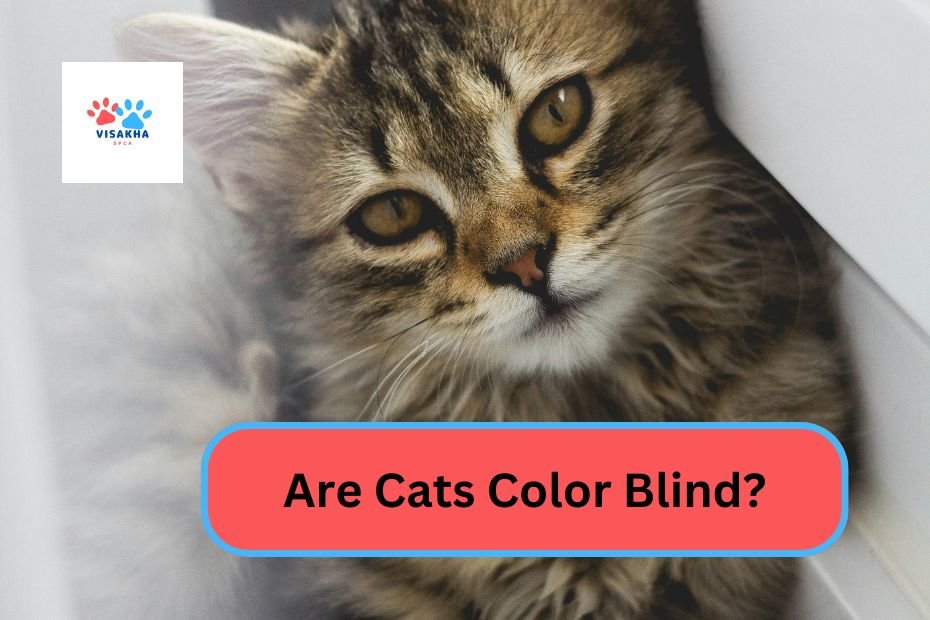The question of whether cats are color blind is an interesting one that has puzzled many pet owners. While cats don’t perceive color in the same way that humans do, they aren’t completely color blind. Instead, cats have a more limited color vision compared to humans. Let’s explore what color blindness means, how cats see the world, and what colors they can actually detect.
What Does Color Blindness Mean?
Color blindness refers to the inability to distinguish certain colors or shades. Humans have three types of cone cells in their eyes that allow us to see a wide range of colors: red, blue, and green. People who are color blind may lack one or more of these cone types, which limits their ability to perceive certain colors.
Cats, on the other hand, don’t see color the same way humans do because they have fewer cone cells in their retinas. This means their color vision is more limited, but they are not completely color blind like some might think.
How Do Cats See the World?
While humans have three types of cone cells, cats only have two. This gives them a type of dichromatic vision, which means they can see certain colors but not the full spectrum that humans do. Cats are thought to see primarily in shades of blue and green, while reds and pinks likely appear as grays or shades of brown.
Here are some key differences between how cats and humans perceive the world:
- Limited Color Spectrum: Cats can see some colors but have difficulty distinguishing between reds and greens. While they can detect blues and yellows more clearly, their overall color range is less vibrant than humans’.
- Better Night Vision: While cats don’t see color as vividly as humans, they are far better at seeing in low-light conditions. Their eyes are designed for night vision, allowing them to see well in dim light. Cats have more rod cells, which are responsible for seeing in the dark, giving them a significant advantage in low-light environments.
- Sharper Peripheral Vision: Cats have a wider field of vision than humans, which helps them detect movement in their surroundings. However, this comes at the expense of sharp focus. Cats can detect movement much better than they can focus on fine details.
- Blurry Close-Up Vision: Cats are nearsighted, meaning that objects far away appear blurry. This is why cats rely more on their sense of smell, hearing, and the ability to detect movement rather than precise visual details when it comes to hunting or navigating their environment.
What Colors Can Cats See?
Although cats don’t have the same color perception as humans, they are not entirely color blind. Here’s a breakdown of the colors that cats are more likely to perceive:
- Blues and Violets: Cats can see shades of blue quite clearly. This is one of the colors they can detect most vividly.
- Greens: Cats can also perceive green, though it may appear more muted compared to how humans see it.
- Reds and Oranges: Red, orange, and similar warm tones are difficult for cats to distinguish. These colors likely appear as gray or dark shades to them.
- Yellows: Cats can see some shades of yellow, but they may not appear as bright and distinct as they do to humans.
Why Cats Don’t Need Full Color Vision
Cats are natural predators, and their vision has evolved to help them hunt in low-light conditions rather than perceive a wide range of colors. Being able to see well in the dark and detect subtle movements is far more important for a cat’s survival than being able to see the full spectrum of colors.
Here’s why cats’ vision is more adapted for their lifestyle:
- Night Hunting: Cats are crepuscular, meaning they are most active during dawn and dusk. Their superior night vision allows them to see prey in low-light environments, which is crucial for hunting.
- Motion Detection: Cats rely more on detecting motion than identifying specific colors. Their ability to spot slight movements in their peripheral vision helps them track prey effectively.
- Sharper Contrast Detection: Cats may not see color well, but they are excellent at distinguishing between different shades and contrasts, which also helps them spot prey in their environment.
How to Play with Your Cat Using Their Color Perception
Understanding your cat’s color vision can also help you choose toys and activities that are more engaging for them. Since cats can see blues and greens more easily, toys in these colors are more likely to catch their attention. On the other hand, red or pink toys might not stand out as much because they appear grayish to cats.
Here are a few tips for playing with your cat based on their vision:
- Choose Blue and Green Toys: Cats are more likely to notice toys that are blue or green, as these colors are within their range of perception.
- Use Movement to Engage: Since cats are excellent at detecting motion, focus on games that involve chasing or pouncing on moving objects, like feather wands or laser pointers.
- Vary Textures: While color may not always grab your cat’s attention, the texture and sound of toys can make them more appealing. Try crinkly or soft toys that make noise when batted around.
Conclusion
While cats are not completely color blind, they do have a more limited color spectrum compared to humans. Cats primarily see shades of blue, green, and gray, with reds and pinks appearing muted or colorless. Their vision is adapted for low-light hunting and motion detection, making them excellent nighttime predators. Understanding how your cat sees the world can help you provide a more enriching environment for them and select toys and activities that are better suited to their abilities.

